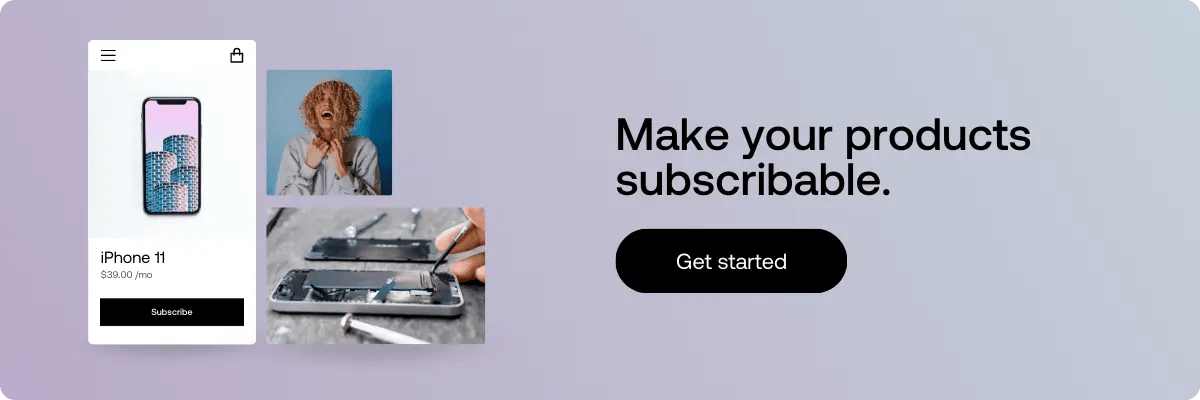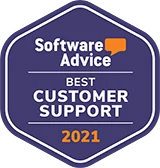A silent revolution is sweeping across the business landscape. What was once limited to magazines, gym memberships, and digital services is now infiltrating the world of physical goods. The subscription model is rapidly gaining ground as a go-to approach for businesses seeking to cultivate loyal, long-term customer relationships.
In this age of consumer empowerment, winning and retaining customers is more critical than ever. Customers have greater control than ever over what they buy, where they buy it, and when they make a purchase. Against this backdrop, subscription marketing has emerged as a powerful tool for businesses looking to establish and deepen customer relationships.
What is subscription marketing?
The marketing function of subscription-based businesses can roughly be divided into customer acquisition, customer retention, and customer advocacy. There's (of course) still a place for flashy marketing campaigns, seasonal promotions, and performance marketing to generate new sales. But subscription marketing is as much about fostering long-term customer relationships. By committing to delivering value over time, subscription marketers tend to pay more attention to the customer journey and what happens after the initial sale.
Anne Janzer defines subscription marketing in her best-selling book Subscription marketing: Strategies for nurturing customers in a world of churn (2020) as follows:
"Subscription marketing is a two-way communication between your company and customers in a subscription relationship, with the purpose of sustaining the value of that relationship for both parties"
Anne Janzer
It demands a deep understanding of the customer journey and a commitment to building lasting relationships based on trust and transparency. For marketers willing to make the transition, the subscription economy presents a huge opportunity to drive growth, foster customer loyalty, and build lasting business success.
This requires a major shift in mindset and a new set of skills, but the rewards can be substantial.
From funnels to flywheels
The marketing funnel is a framework that describes the journey a customer takes as they progress from being unaware of a product or service to becoming a loyal customer. The funnel is divided into several stages, each representing a different level of awareness, engagement, and commitment. These stages include:
-
Awareness
-
Interest
-
Consideration
-
Intent
-
Purchase
-
Loyalty
On the other hand, the marketing flywheel represents a circular, customer-centric approach to marketing that seeks to create momentum and drive growth over time. The flywheel model is based on the idea that marketing efforts should focus on delivering a great customer experience that encourages customer loyalty, advocacy, and repeat purchases. This, in turn, generates a self-sustaining engine for growth. The marketing flywheel consists of three key stages:
-
Attract
-
Engage
-
Delight
The main difference between the marketing funnel and the marketing flywheel is the focus on customer experience and the role of customer advocacy in driving growth.
The marketing funnel is a linear model that views the customer journey as a series of stages, starting with awareness and ending with loyalty. The funnel is often used to guide marketing strategies that focus on moving customers from one stage to the next, with the goal of converting them into paying customers.
In contrast, the marketing flywheel is a circular model that places greater emphasis on customer experience, loyalty, and advocacy. Rather than viewing the customer journey as a linear process, the flywheel focuses on creating momentum and driving growth over time by attracting new customers, engaging with them in a personalized way, and delighting them to the point where they become loyal and even advocate for the brand.
Subscription marketers recognize that the customer journey is never simple enough to be put into a linear model. Therefore, subscription businesses have widely adopted the flywheel model when designing their marketing strategies.
Why are people interested in subscriptions?
The rise of subscriptions is changing how consumers purchase products and services. Instead of making one-off purchases, consumers are opting for a more convenient and personalized approach to shopping, driven by the growing popularity of subscriptions.
Before moving to the practical examples of creating a subscription marketing strategy, it is essential to understand why people are looking for subscriptions. So, let's take a closer look at some of the key motivators.
Convenience: Subscriptions offer a hassle-free way for consumers to receive products or services regularly without the need to make individual purchases continuously. This convenience factor is a significant draw for consumers, who are increasingly looking for ways to streamline their lives. By subscribing, consumers can reduce the time and effort required to make purchasing decisions. This can be especially appealing for those who struggle with decision fatigue or just want to simplify their lives.
Savings: Some subscriptions offer discounts or other benefits compared to purchasing products or services individually. Whether a monthly box of goodies or a discounted gym membership, subscriptions can provide ongoing savings for consumers. Furthermore, subscription-based pricing decreases the one-off investment consumers have to make to access especially high-end goods is lower (imagine electronics, home appliances, design furniture, high-end sports equipment, etc.). This removes some of the pain that large investments inflict on the consumer's mind and wallet.
Customization: Many subscription companies offer the ability to customize the products or services received, giving consumers a more personalized experience. From tailored wardrobe services to customized skincare boxes, subscription services allow consumers to tailor their purchases to their individual needs and preference. Regarding long-term subscription rentals of durable goods, subscriptions enable users to try out and switch between different models with much less effort than buying the product outright.
Access to exclusive content and services: Subscriptions often provide consumers exclusive content or services unavailable to regular customers. From early access to new products to VIP experiences, subscriptions can offer a range of benefits for consumers.
Community: By subscribing to a product or service, consumers become part of a group of like-minded individuals with similar interests or needs. This sense of belonging can foster a strong emotional connection with a brand or company, leading to increased brand loyalty. Subscriptions also allow for ongoing engagement between the brand and the consumer, creating a more intimate relationship.
The trend towards subscriptions and buying products as a service is a larger story about human behavior and reflects a shift in consumer expectations. As more customers become accustomed to subscriptions, they expect the same convenience and delight in areas where subscriptions haven't been mainstream yet, affecting nearly every industry.
In conclusion, the rise of subscriptions is changing how consumers purchase products and services. With a focus on convenience, customization, and savings, subscriptions are becoming an increasingly popular way for consumers to shop and for companies to market their products and services.
What does the subscription business model offer for businesses?
Besides the often-mentioned benefits related to subscriptions, like recurring revenues and longer customer relationships, the subscription model can unveil some strategic advantages.
Competitive differentiation: Subscription business models can help companies differentiate themselves from their competitors. Especially if you're the first-mover in a highly saturated market, you may gain substantial advantages compared to your competition helping you to stay more responsive to changes in the market and consumer preferences.
Market expansion: Subscription pricing strategy allows companies to expand vertically to new markets. By offering customers the convenience, value, and predictability of a subscription model, businesses can tap into new customer segments that were previously out of reach. For example, a luxury brand can reach new customers for whom the brand's products have previously been out of reach due to high prices.
Data and insights: Subscriptions provide valuable data and insights about customers that go further and more profound than in the traditional sales model. By tracking and analyzing subscriber behavior and preferences, companies can gain a deeper understanding of their customers, pain points, and motivations and use this information to improve their products and services.
Increased brand awareness: Subscriptions can help companies increase brand awareness by building a loyal customer base. By providing constant value to their customers through various subscription marketing tactics, companies have a great chance to turn their customers into brand ambassadors who help spread the word about the company's products and services.
Subscription marketing at different stages of the customer relationship
Acquiring new customers
As a subscription marketer, acquiring new subscribers to your service is an ongoing necessity. But that's just the tip of the iceberg in today's subscription-driven world. Instead, you must delve deeper into the customer journey to drive growth and success.
In the following section, we uncover how subscription businesses can effectively attract new customers while supporting growth further down the customer journey.
Target with precision
The key to successful subscription marketing is attracting the right customers who will derive the greatest benefit from your subscription service. Focusing on targeting ensures that your marketing efforts are directed toward the people most likely to become long-term customers. This not only saves time and resources but also increases the chances of conversion. To find the optimal customer segments to target, you should research your audience, identify their pain points and preferences, and tailor your value proposition accordingly.
Refine your messaging
A compelling message that resonates with your target audience is critical to the success of your subscription marketing efforts. To hone your messaging, you should understand the needs and desires of your most promising customer segment and create a value proposition that speaks directly to them.
The language you use, the images you choose, and the tone of your messaging should all be designed to connect with your target audience on an emotional level. By doing so, you increase the chances that they will take action and become a subscriber.
Choose the right channels
The marketing channels you use can make or break your customer acquisition efforts. To reach your target audience effectively, you must choose the channels they are most likely to use. This may include social media platforms, email marketing, pay-per-click advertising, or influencer marketing, among others.
Selecting the right channels and creating campaigns tailored to each one increases the chances that your message will reach your target audience and drive conversions.
Data-driven optimization
Gathering data and monitoring your campaigns' performance is essential to improve your customer acquisition efforts continuously. By tracking metrics such as click-through rates, conversion rates, and customer acquisition costs, you can identify areas for improvement and make data-driven decisions.
You can also use this data to optimize your campaigns and test new strategies, which will help bring down your customer acquisition costs over time. You can stay ahead of the curve by continually monitoring and refining your campaigns.
Customer retention through long-term value creation
Value nurturing is the essence of the subscription marketer's playbook. Conveying continuous value to your customers requires that different business functions, including marketing, customer success, support, sales, and product development, work together. Janzen (2020) sums it up nicely:
"Marketing creates the promise. The whole business fulfills it."
In the following section, we'll navigate the different customer journey phases and provide examples of how various business areas can nurture and sustain customer value.
Customer success
In the world of subscription marketing, customer success is everything. Businesses that fail to deliver a seamless, memorable experience risk losing subscribers in the first moments of the relationship, which is reflected in high customer churn. So how can companies ensure that their customers stay engaged, motivated, and satisfied over the long haul?
Customer Success professionals talk a lot about Time-to-Value. Time-to-Value is a metric that measures how quickly customers can derive value from a product or service after they start using it. In the context of subscription marketing, time to value refers to the time it takes for a subscriber to realize the benefits and value of the subscription — for example, how long it takes a customer to use the product three times.
The first step to reducing customers' perceived time-to-value is a well-crafted welcome message. It can be an email, a handwritten letter inside the package, or even a multisensory experience. A welcome message should set the tone and provide valuable tips to help subscribers get up to speed. Providing links to videos and other guidance materials can also be effective in reducing time to value and helping your subscribers achieve critical milestones.
Finally, by quantifying the value of the subscription, whether in terms of usage or monetary savings, businesses can reinforce the benefits and keep customers returning for more. There are several ways to quantify the value of a subscription service in terms of usage and monetary value and communicate it to users. You can, for example, share your customer's achievements based on their usage data, highlight their savings, and create comparisons of the differences between buying and subscribing.
Key takeaways:
-
Make the first steps memorable with a well-crafted welcome email.
-
Reduce time to value by providing sufficient guidance from the get-go.
-
Help customers through critical milestones.
-
Quantify your value.
Customer retention
Once subscribers are on board, the challenge becomes keeping them engaged and satisfied. For subscription businesses, this means offering ongoing value to your existing customers through various channels.
From training programs that address each customer's needs to stories that highlight the service's value and use cases in different contexts, businesses must be creative and strategic in their efforts to retain customers. In the age of content marketing, this also means creating value through high-quality, inspiring, and educational content that informs and entertains your audience.
Subscription businesses can create case studies demonstrating the service's real-world value for actual customers. These case studies can showcase specific use cases, success stories, and testimonials from satisfied customers and can be a powerful tool for adding social proof and communicating the benefits and value of the service.
Another excellent example of content that works in almost any context is How-to content. Particularly in video format, how-to content is a versatile and practical type of content that both inspires and educates. For instance, a company selling subscriptions to grills and cooking equipment can generate an endless array of recipe and cooking tips content, providing their customers with valuable guidance and inspiration for their culinary endeavors.
Lastly, creating a sense of belonging through community is vital for subscription businesses because it helps to increase customer engagement, loyalty, and retention. When customers feel like they are part of a community, they are more likely to maintain a positive emotional connection with the service. Getting started with your community-building efforts doesn't need to be complicated. Many subscription businesses have built vibrant communities using social media and third-party platforms. Let's say you have a bike shop and sell bicycle subscriptions for high-end bikes. In this case, Strava could be a relevant platform for your customers to connect and share their experiences.
Key takeaways:
-
Offer training that helps your customers get more value from your subscription offering.
-
Share stories — those that tell your customers' experiences and add social proof but also your own. People connect with companies they can share their values with, and storytelling is one of the best ways to communicate those.
-
Create value through content that inspires, educates, and entertains.
-
Create a community and a sense of belonging. Consider using social media groups, niche platforms relevant to your subscribers, or even organizing member events.
Turn your customers into fans and advocates
At the heart of subscription marketing lies the ultimate goal: turning customers into fans and advocates who champion the service to others. However, achieving this goal is no easy feat and requires a holistic approach that includes strategic customer acquisition, success, and retention efforts.
By acquiring the wrong profile of customers, you drive out at the first corner. Failure to deliver value and retain your customers means you won't have anyone to endorse your products and services. The entire customer experience determines whether you, as a brand, have a chance to succeed in advocacy marketing.
Brand advocacy starts with the values shared by the customer and the company. Without shared values, there is no ground for authentic brand endorsement. Patagonia is probably one of the most used (and for a good reason) examples of how to build a brand around values. Their brand has helped the company attract a loyal following and become a subject of positive discussion across various mediums, from coffee tables to mainstream media.
Your next task is to turn repeat customers into brand endorsers, which is undoubtedly easier with your most loyal and active subscribers. For example, look who shares recommendations on social media, submits reviews or feedback, or helps other users gain value from the service. Then find ways to motivate these customers while maintaining authenticity. Keep in mind that money is rarely the best motivator. Therefore, try coming up with other creative ways to develop, support, and reward your brand's advocates.
Another good way to exceed expectations and maintain relationships is by celebrating successes and milestones together. Whether it's about exceeding a certain threshold in usage, achieving a milestone, or an anniversary, show that you care and remember. Often, a simple personal message is enough to create a positive feeling. This is also the kind of content people like to share on social media. Just imagine everyone's IG stories when Spotify publishes its' annual Spotify Wrapped stats, and you get the point.
Finally, you have a shot to sell more to your customers. When done right and at the right time, upselling and cross-selling to existing customers can actually be a value-adding experience from the customer's perspective.
By offering relevant and personalized recommendations, businesses can help customers discover new products or services that meet their specific needs and preferences. This can save customers time and effort in researching and comparing options on their own.
Additionally, upselling and cross-selling can provide customers with more comprehensive and integrated solutions that deliver better value and user experience. When executed with transparency, empathy, and respect for the customer's autonomy, upselling and cross-selling can be a win-win situation for both the business and the customer, deepening the relationship and creating more loyal and engaged customers.
Key takeaways:
-
Share your values. Not only the value of your products and services but try finding ways to connect with your customers on a deeper level.
-
Celebrate success. There is always a good reason to celebrate. Whatever the reason, share it with your customer.
-
Upsell and cross-sell at the right moment. Instead of feeling pushy, a successful upselling experience can be value-adding and deepen the relationship.
Adopt new metrics
In the fast-paced and competitive world of subscription businesses, tracking Key Performance Indicators (KPIs) is crucial to success. These metrics provide valuable insights into a company's performance, enabling data-driven decisions that can drive recurring revenue growth and improve customer lifetime value.
However, measuring KPIs is not just about crunching numbers; it's about understanding the customer journey and identifying areas for improvement to create a positive and engaging experience. By monitoring these metrics regularly, companies can make the necessary adjustments to keep on the growth track.
Since subscription-based business models prioritize long-term customer retention over one-off transactions, they require different metrics than traditional business models. While conversion metrics are still important, greater attention should be paid to the later stages of the customer relationship to ensure that the subscription remains a valuable and relevant experience for the customer.
Check out our blog about subscription KPIs to learn more.
Conclusion
Subscription marketing is not a marketing playbook for subscription businesses. Instead, it is a customer-centric mindset that can help any company succeed in a competitive and ever-changing market.
By focusing on the critical phases of the customer journey - acquisition, success, retention, and advocacy - and adopting the right strategies and metrics, businesses can create a sustainable and profitable business model that benefits both the customer and the company.
At the core of subscription marketing is the goal of building lasting relationships and delivering meaningful value to customers. With the right approach, companies can create loyal and engaged customers who become passionate advocates for their brands.
You can't go wrong by putting the customer at the center of your business model. So why not start today?









